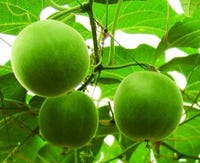Tate & Lyle builds on sugar-coated history with monk fruit sweetenerTate & Lyle builds on sugar-coated history with monk fruit sweetener
Best known as the makers of Splenda, Tate & Lyle adds to its line of sweeteners with a monk fruit extract. Monk fruit is trending this year as a low-cal, low-glycemic sweetener for food and beverages.
July 22, 2011

Tate & Lyle has a storied history that traces back to the UK introduction of the first sugar cube in 1875. The abridged version: Henry Tate and Abram Lyle's sugar businesses competed against one another until 1921 when the rivals merged to own 50 percent of the UK's refined sugar business. Fast forward to 1976 when Tate & Lyle and researchers discovered sucralose, the no-calorie sweetener they developed and branded with McNeil Nutritionals as Splenda.
In 2004, Tate & Lyle became the sole manufacturer of Splenda and responsible for global sales to food and beverage manufacturers, while the trademark and tabletop sales remain owned by McNeil Nutritionals. Tate & Lyle now sells a range of branded food ingredients such as Promitor Dietary Fiber and Sta-Lite Polydextrose, paper starches and staple ingredients such as high fructose corn syrup, ethanol and citric acid.
"We've been one of the pioneers for zero-calorie sweeteners," said Pashen Black, marketing communications manager for the Americas. Putting its stake in the ground first has paid off. By volume, Splenda Sucralose accounts for 89 percent of the global sucralose market, according to Tate & Lyle. And within the high-intensity sweetener market, Splenda has a 26 percent share, making the company the largest single intensity sweetener manufacturer in the world. The company estimates that 70 percent of households have a product with the Splenda logo.
 Now in 2011, the company is introducing another sweetener to round out its portfolio: Purefruit Monk Fruit Extract. At about 200 times the sweetness of sugar (Splenda is 600 times as sweet; stevia, about 350 times), the monk fruit, or luo han guo, got its name from Buddhist monks who first cultivated it some 800 years ago. It grows in the hillsides of Asia, is harvested by hand and then crushed and mixed with hot water to bring out its sweetness.
Now in 2011, the company is introducing another sweetener to round out its portfolio: Purefruit Monk Fruit Extract. At about 200 times the sweetness of sugar (Splenda is 600 times as sweet; stevia, about 350 times), the monk fruit, or luo han guo, got its name from Buddhist monks who first cultivated it some 800 years ago. It grows in the hillsides of Asia, is harvested by hand and then crushed and mixed with hot water to bring out its sweetness.
Black said the impetus to develop Purefruit was the desire to serve Tate & Lyle's food and beverage customers who are seeking all sorts of label claims, including reduced calorie, reduced sugar or natural. "Depending on the type of label they want, we have all the sweetening options for them," said Black. "For us, that was the impetus to develop Purefruit. We wanted to deliver the purity of a sweetener that comes from a fruit and that tastes great." Purefruit can be added to baked goods, beverages, cereals, confections, dairy, desserts, dressings, ice-cream and nutritional supplements.
Tate & Lyle isn't just about supplying ingredients, however. "We establish a partnership with food manufacturers, rather than just being a supplier of ingredients. We have a technical services team that can go into their labs and work with them," said Pashen. "It's an integrative approach."
The company also spends a lot of time listening to what consumers want, relying heavily on consumer insights to develop new applications for their ingredients. "We do tons of consumer research globally as a company to find out what consumers want from health and wellness," said Pashen. "We use that as a foundation to start thinking about new products."
Fast facts: Luo han guo
A member of the squash family, luo han guo (Momordica grosvenorii/Siraitia grosvenori) or monk fruit, is native to the mountains of China and Japan.
It's 200 times sweeter than sugar.
It's used as a low-caloric, low-glycemic sweetener for food and beverage applications.
The active ingredients are primarily compounds classified as triterpene glycosides, which are responsible for the sweet taste and also some functional aspects.
Monk fruit's pleasant, sweet honey taste can mask the bitter aftertaste from stevia.
Functional Ingredients predicted in January that luo han guo would be an ingredient to watch.
About the Author
You May Also Like



